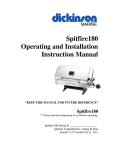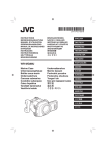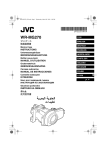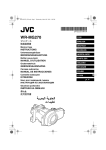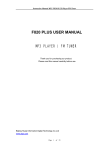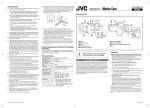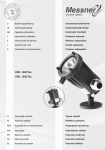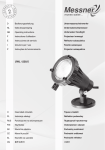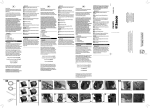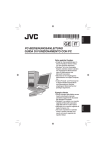Download JVC WR-MG88U User's Manual
Transcript
INSTRUCTIONS BEDIENUNGSANLEITUNG MANUEL D’UTILISATION GEBRUIKSAANWIJZING MANUAL DE INSTRUCCIONES ISTRUZIONI INSTRUÇÕES INSTRUKTIONSBOG KÄYTTÖOHJE BRUKSANVISNING BRUKSANVISNING NÁVOD K OBSLUZE INSTRUKCJA OBSŁUGI HASZNÁLATI UTASÍTÁS ИНСТРУКЦИЯ ПО ЭКСПЛУАТАЦИИ 使用說明書 ဧႁීၗ 사용 설명서 DEUTSCH FRANÇAIS NEDERLANDS CASTE.ESP. ITALIANO PORTUGUÊS WR-MG88U Marine Case Unterwassergehäuse Boîtier sous-marin Onderwaterhuis Carcasa submarina Custodia subacquea Caixa Aquática Vandtæt kameraetui Vesitiivis kotelo ENGLISH Undervattenshus Marine kassen Podvodní pouzdro Podwodna obudowa Tengeri tok Бокс для подводной съемки 潛水盒 ༅ၺఫ 수중용 케이스 DANSK SUOMI SVENSKA NORSK ČEŠTINA POLSKI MAGYAR РУССКИЙ 中文繁體 ᒦᆪ଼ᄏ 한국어 In order to use this product safely Preparation (墌 pg. 4) • Check that there is no dirt, cracks, or damage to the O-ring. • Always apply grease to the O-ring. Attaching the Marine Case to the Camera (墌 pg. 5) • Make sure that the O-ring is not twisted, and that you do not forget to attach it. • When tightening the seal, make sure there are no foreign objects caught in the seal. Recording the Video/Still Image Files (墌 pg. 6) • Avoid opening and closing the marine case in the shooting location. • When holding the marine case, lower it gently into the water. Detaching the Marine Case/Maintenance (墌 pg. 7) • Always wash the marine case in fresh water after use. • Perform maintenance on the O-ring. If water leaks into the case due to careless use of the marine case, JVC cannot accept responsibility for any damage that may occur to the internal equipment and materials (video camera, SD card etc), or any expenses incurred in taking the photographs/video. Therefore, please be careful when using the marine case. 2 Safety Precaution Before use, this unit must be pretested to check if there is any water leakage. Please read before use This marine case is a precision instrument designed to permit safe video recording under high water pressure. Please pay careful attention when handling the unit before and after use, as explained in this user’s manual. Each part of the marine case has been subject to strict controls during the manufacturing process, and the individual functions have faced stringent tests during the assembly process. Each marine case has also had to pass waterproof inspections using high-pressure water testers. However, damage can sometimes occur during transport and distribution, or during storage after purchase, so before diving always carry out the following preuse test to verify safety. Pre-use test Be sure to perform the following pre-use test before diving. 1. Before mounting the camera inside the marine case, dive with only the empty marine case and test for water leaks. Allow 5 or 6 minutes to ensure there are no leaks. Be sure to perform this test to ensure the safety of your camera. 2. The following are some common causes of water leaks: A. The marine case is used without attaching the O-ring. B. The O-ring is not mounted in the correct position. C. The O-ring is damaged or deformed. D. There is sand, dirt, hair or other foreign matter on the O-ring. E. There is sand, dirt, hair or other foreign matter on the contact surface of the O-ring or on the inside of the lid. F. The provided strap or silica gel bag is pinched inside the marine case when the lid is closed. 3. Check that there are no scratches or cracks on the marine case every time you use it. The marine case must withstand water pressure with use. Repeated exposure to pressure eventully leads to material fatigue, which may result in damage of the marine case. Every time you use the marine case, check in advance that there are no scratches or cracks. If you frequently use the marine case, be sure to ask for maintenance at the store of purchase. (There is a charge for maintenance.) To protect your camera and ensure optimum use, keep the examples listed above in mind when using the marine case. JVC accepts no responsibility for water leakage or damage to anything inside the marine case (camera, SD card, etc.) due to careless usage of this product. Be sure to follow correct procedures when using the marine case. Accessories • Glass cleaner (to prevent “steaming up”) • Cleaning fluid (to remove dirt) • Silicone grease • Silicone cloth • Silica gel (Preservative) • Lens tissue paper • Swab • Strap • 2 O-rings : 1 Spare • Base (A,B) The attachment base differs depending on the model of camera that you have. • Grip Commercially available lights and weights can also be attached. • Pick • Screw tightening key • 2 hexagonal wrenches Large: for assembling grip Small: buckle opener • Lens hood Only attached to certain types of cameras. Maintenance Kit – Sold Separately (Part Number: MG8_MTKIT) You can purchase the following set of expendable parts. Please contact your local JVC service representative. • O-Ring x2 • Silicone grease (5 g) x1 • Silica Gel (preservative) (2 g) x5 • Lens tissue paper (50 sheets) x1 3 Index Preparation 1 Inspect the main casing for scratches and cracks etc. Apply 2 or 3 drops of the glass cleaner provided onto one of the lens tissues or a clean cloth, and wipe the inner side of the marine case front glass. Strap Front glass 2 Using the supplied pick, remove the O-ring from the main case. Bottom view Main casing grip: Attach the included strap as shown in the diagram above. Zoom lever Ring: Commercially available filters (67mm diameter) etc can be attached. Buckles (4 places): Seal the marine case. Grip attachment holes: You can attach the included grip, or commercially available weights etc. Still image shooting button Video recording start/stop button Power/mode switch lever: Turns camera’s power on/off, or switches video or still mode. 4 Check the O-ring. Check the O-ring, O-ring contact surface, and groove in which the O-ring fits for dirt, scratches, or damage etc. visually and by touching with your finger. 3 Apply grease to the O-ring and re-attach. 4 Close the empty marine case (no camera inside). 5 Place the marine case in water, and check that there are no water leaks. Attaching the Marine Case to the Camera 1 5 Insert the camera into the marine case. Inserting the provided silica gel between the camera and marine case prevents the inside of the marine case from steaming up. Pull the power/mode switch lever of the marine case in the direction of the arrow ( ), and rotate it to lock it ( ). Silica gel If the power/mode switch lever is not locked, it may touch or damage the camera when the camera is put into the case. Tighten the grip belt. Base attachment groove Base Marine case internal base 2 For cameras that are equipped with Base A, attach the lens hood. Attach the base in the correct way for your model of camera. (墌 pg. 7) • Line up the tripod screw hole on the base of your camera with the base holes of the case, and tighten the screw. • Install the battery (and insert an SD card if needed) beforehand. 6 Seal the marine case, and attach the grips. Lock in all 4 places. 3 Setup the camera (please refer to your camera’s instruction manual). • Turn off the flash and light. (presence of a flash/ light differs according to the model.) • Switch off the power. • It is recommended to set to the auto recording mode. • Open the lens cover. 4 Open the marine case. If it is difficult to open buckles, use the buckle opener. Hexagonal wrench (small) NOTE The risk of water leakage is extremely high if the O-ring is twisted, if you forget to attach it, or if something is trapped in the seal. 5 Recording the Video/Still Image Files 2 Before recording Submerge the marine case with the camera equipped into a bathtub or water tank full of fresh water. Gradually increase the amount of time the marine case is submerged as shown below. • 1st time: 5~10 seconds • 2nd time: 30 seconds ~ 1 minute • 3rd time: 3 minutes ~ 5 minutes (try operating the levers and buttons while the marine case is submerged). Press the video recording start/stop button or the still image shooting button to start recording. Still image shooting button Zooming (Telephoto) Zooming (Wide angle) Video recording start/stop button NOTES • Always have someone hold the marine case for you when diving into, or getting out of water. • If for any reason water leakage occurs, remove the camera battery. It may cause the camera to explode. 3 When you have finished recording, rotate the power/mode switch lever to turn the camera’s power off. The camera’s power lamp goes out. 1 Pull the marine case power/mode switch lever to release the lock, and switch on the camera’s power. Rotate the lever to switch on the camera’s power. The camera’s power lamp lights. 8 Switching between video/still modes Switch modes by rotating the lever. 6 NOTE Sometimes, due to sudden shaking or impact to the marine case, the camera’s drop detection function operates to switch off the camera’s power. When [VIDEO MANAGEMENT FILE IS BROKEN. TO RECORD/PLAYBACK VIDEO, RECOVERY IS REQUIRED. RECOVER?] is displayed, press the REC button to recover the file. Detaching the Marine Case/Maintenance Always perform maintenance on the marine case after you have finished recording. Failing to perform maintenance on the marine case will allow dirt to build up on the case, causing water leaks. 1 Wash the marine case in water while it is still sealed. • If the marine case was used in seawater, we recommend submerging the marine case in fresh water for a while to remove salt. • Move the buttons and levers while the marine case is submerged, and rinse the salt out from any gaps or grooves etc. 2 Wipe off the water with a dry cloth, and allow the marine case to completely dry out. 3 Open the marine case, and remove the camera. Storing the O-ring If you do not intend to use the marine case for longer than 1 month, remove the O-ring from the marine case, and spread a thin layer of the supplied silicone grease over the entire O-ring. After that, place the O-ring inside a clean plastic bag, and store it in the maintenance kit case. The O-ring is an expendable part. Replace the O-ring with a brand new one every year. NOTES • When re-using an O-ring after storage, always check the condition of the O-ring. • Never use an O-ring if it is deformed (crushed, distorted), cracked, or damaged in any way. Lock Main Specifications Maximum pressure Water depth up to 30 meters Operations Power on/off Video recording start/stop Still image shooting Zoom (telephoto/wide angle) Also wipe the groove in which the O-ring was inserted, and the part of the marine case that was in contact with the O-ring, and allow them to dry. Buoyancy +400 g (with the camera inserted and the supplied battery pack attached) Main unit dimensions (W x D x H) 233 mm x 172 mm x 132 mm Wipe the inside of the marine case with a dry cloth. Main unit weight Approx. 800 g (not incl. grip) Remove 4 5 Remove the O-ring, and wipe off any salt, sand, and any other debris. Drop a few drops of the cleaning fluid onto the inside of the front glass, and wipe it off using the silicone cloth etc. Applicable model Base A: GZ-MG130 ~ 275 and base to be Base B: GZ-MG555 ~ 575 used Filter diameter ø 67.0 mm NOTES • Do not leave the marine case in direct sunlight. Doing so may cause discoloration to the case, and may cause the O-ring to deteriorate more quickly. • When storing the marine case, unlock the power/ mode switch lever. • If you cannot avoid opening the marine case at the diving point, make sure that drops of water from your hair or your body do not drop into the case. 7 © 2007 Victor Company of Japan, Limited Printed in Japan 0307FOH-AL-VP WR-MG88_EN_A5.book Page 0 Thursday, May 3, 2007 9:06 AM WR-MG88U Procedures for Using the Supplied Maintenance Kit Vorgehensweise bei der Anwendung des mitgelieferten Wartungssets Procédures pour l’utilisation de l’ensemble d’entretien fourni Procedures voor het gebruik van de bijgeleverde onderhoudskit Procedimientos para utilizar el kit de mantenimiento suministrado Procedure per l’utilizzo del Kit di manutenzione in dotazione Procedimentos para a utilização do kit de manutenção fornecido Procedurer ved anvendelse af det medfølgende vedligeholdelsessæt ENGLISH Mukana toimitetun huoltopakkauksen käytön menettelytavat Hur man använder den medföljande underhållsutrustningen Prosedyrer for bruk av det medfølgende vedlikeholdssettet Návod k používání sady na údržbu Procedury używania dostarczonego zestawu do konserwacji A mellékelt szerelési készlet használata Порядок использования комплекта для ухода 使用隨附之維修工具組的 步驟 附带维护用具的使用程序 DEUTSCH FRANÇAIS NEDERLANDS CASTE.ESP. ITALIANO PORTUGUÊS DANSK SUOMI SVENSKA NORSK ČEŠTINA POLSKI MAGYAR РУССКИЙ LYT1742-002A WR-MG88_EN_A5.book Page 2 Thursday, May 3, 2007 9:06 AM Procedures for Using the Strap (J Page 4) Pass the strap through the strap attachment hole before using the marine case to maintain a firm grip in water. Silicon cloth Wash the marine case with fresh water, and wipe the outer side with the silicon cloth after drying. Strap attachment hole Buckle opener (Hexagonal wrench (small)) Buckle Grip belt of camera (J Page 5) For use when you have difficulty opening the buckle. Hook the wrench to the buckle and pull towards you. Buckle 2 Silica gel (anti-fogging agent) (J Page 5) Prevents fogging inside the marine case. Insert it between the camera and the camera grip belt before inserting the camera into the marine case. Caution: The moisture absorption ability of silica gel that has previously been used may deteriorate depending on the conditions of use. As such, we recommend that the silica gel be replaced each time. WR-MG88_EN_A5.book Page 3 Thursday, May 3, 2007 9:06 AM Supplied Maintenance Kit Glass cleaner (J Page 4) (to prevent fogging) Apply the glass cleaner on the front glass before using the marine case. Add two to three drops of the cleaner on a lens tissue paper, and wipe the inner side of the front glass. Marine case Front glass Cleaner liquid (J Page 7) For removing dirt from the front glass after using the marine case. Add two to three drops of the cleaner on a lens tissue paper, and wipe the inner side of the front glass. Lens tissue paper (J Page 4) Camera base Use the lens tissue paper when applying the antifog liquid on or removing dirt from the front glass. Screw tightening key (J Page 5) Use the key to tighten the screw of the camera base. 3 WR-MG88_EN_A5.book Page 4 Thursday, May 3, 2007 9:06 AM O-ring Rubber ring for waterproofing. Check to ensure that the ring is not twisted and foreign materials are not attached, followed by attaching it to the designated position. Dirt, sand, salt crystals, etc. Hair, thread, etc. O-ring Swab For cleaning the O-ring groove. Press it lightly against the O-ring groove and move it around the circumference of the groove. Swab 4 WR-MG88_EN_A5.book Page 5 Thursday, May 3, 2007 9:06 AM Pick For removing the O-ring. To remove the O-ring, insert the pick between the O-ring and the O-ring groove. Pick O-ring O-ring groove Silicon grease For protecting the O-rings and preventing water leakage. Check to ensure that there is no foreign substance on the O-ring before applying the grease. Squeeze about 1 cm of the grease onto your finger, and apply it on the O-ring by holding the O-ring with your fingers. * Do not pull the O-ring with force. About 1 cm O-ring Grease Precautions O-ring is important as it keeps the marine case airtight. Failure to attach it correctly may cause water to enter the marine case and the camera inside to malfunction as a result. Pay careful attention when attaching the O-ring. 5 WR-MG88_EN_A5.fm Page 6 Wednesday, May 9, 2007 10:06 AM After shooting (sea salt removal) Make sure to perform maintenance on the marine case. Salt crystal or dirt will accumulate inside the marine case if maintenance is not performed, and this may cause water leakage. A Prepare a container that contains fresh water that is five times more than the volume of the marine case. • If only small containers are available, pour in fresh water that is equivalent to at least five times the volume of the marine case over a few times, followed by performing salt removal in G. Example: Container with volume J Pour in water over 5 times equivalent to 1 marine case • The container must be big enough to allow the marine case to submerge fully. • Perform salt removal for the grip as well. B After diving, submerge the marine case in fresh water for 30 minutes without removing the camera. C Temporary salt removal Shake the marine case in the upward, downward, left and right directions for at least 10 times, followed by rinsing it. • If you do not need to take out the camera immediately, proceed to G for the actual salt removal. D Remove the marine case and wipe off water droplets on the case surface using a dry cloth. 6 WR-MG88_EN_A5.fm Page 7 Monday, May 14, 2007 8:52 AM E Face the front glass of the marine case upwards, and open the buckles to remove the camera, while paying attention not to let water droplets at the O-ring or buckles enter the case. Front glass F Upon removing the camera, close the marine case again while paying attention not to allow water droplets enter the case, followed by tightening all the buckles. G Final salt removal Submerge the marine case in fresh water for at least 1 hour to remove salt. • Shaking the case body in the upward and downward directions and rinsing it helps to remove salt more effectively. • Make sure the marine case is fully submerged in the fresh water. H Remove the marine case and wipe off water droplets on the case surface using a dry cloth. Then open the buckles to allow the inside and outside of the case to dry thoroughly. Memo • Temperature, humidity, water temperature, salinity and other conditions vary according to the environment of use. 7 BackCover.fm Page 5 Friday, May 11, 2007 10:21 AM © 2007 Victor Company of Japan, Limited Printed in Japan 0507MNH-SW-OT
















